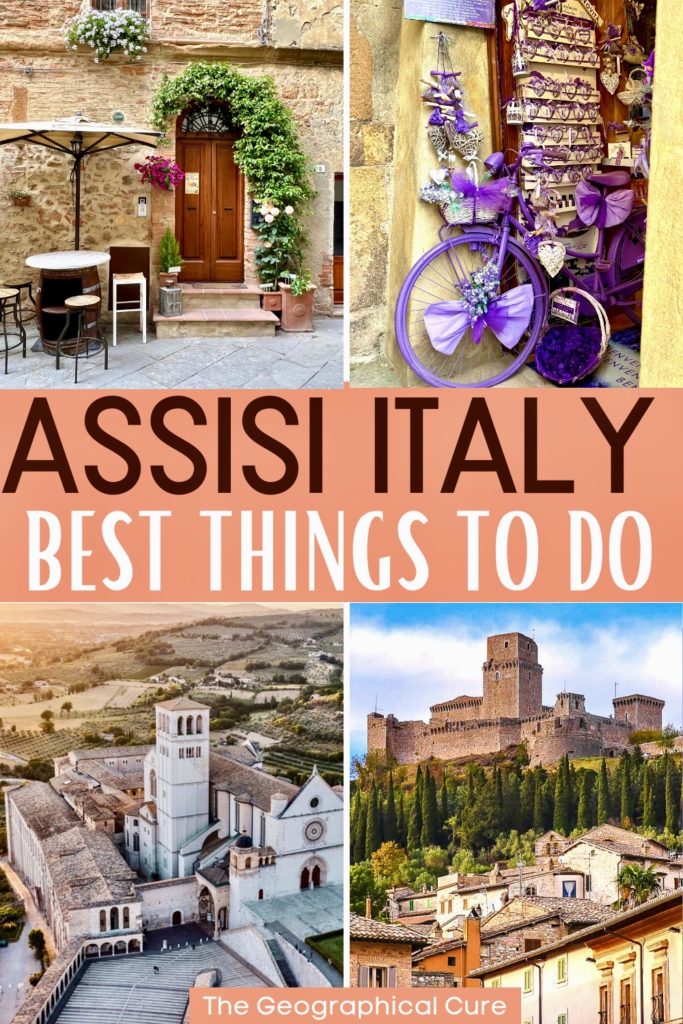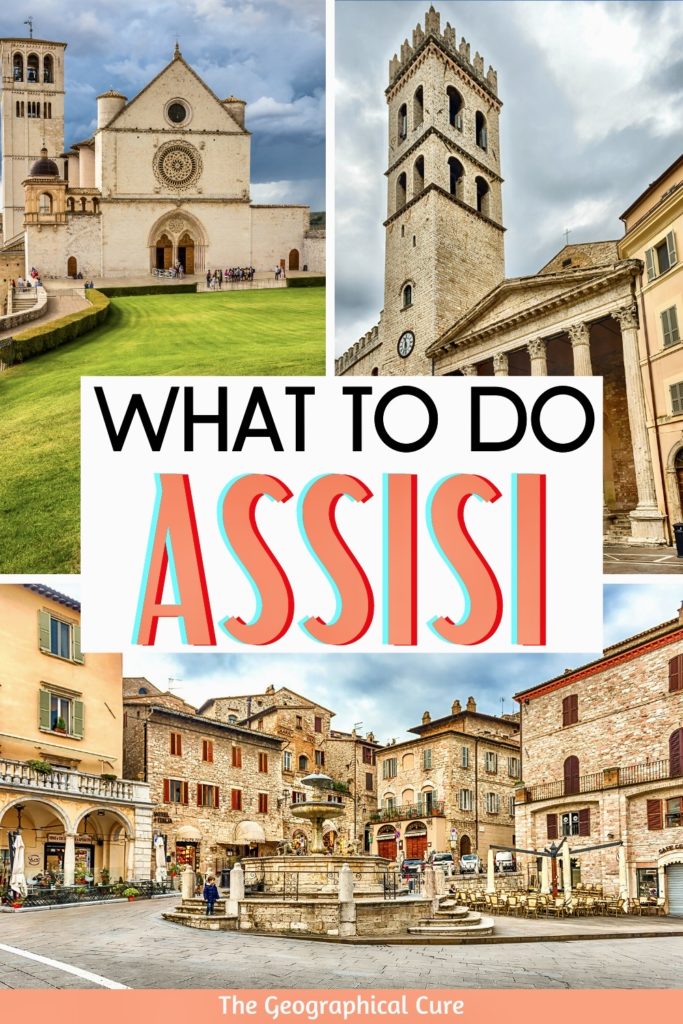Nestled atop Mount Subasio in the picturesque region of Umbria, lies the enchanting town of Assisi, a UNESCO World Heritage site.
Despite its small size, Assisi packs a punch when it comes to culture. The town is home to awe-inspiring Roman ruins, frescoed churches, charming sun-bleached piazzas, and a rugged fortress with sweeping views.
The approach to the town is nothing short of magical, setting the stage for a truly unforgettable experience.
Assisi is renowned for being the birthplace of Saint Francis, the medieval monk who is revered as Italy’s most beloved penitent saint. Francis’s legacy lives on in the town, and visitors can explore his story and teachings while admiring the town’s beauty.
Rejecting his father’s wealth, Francis chose to live a simple life, walking barefoot with the poor and communing with nature.
For centuries, pilgrims have trekked the town’s narrow and winding streets to pay homage to Francis. Assisi attracts 4-5 million visitors annually.
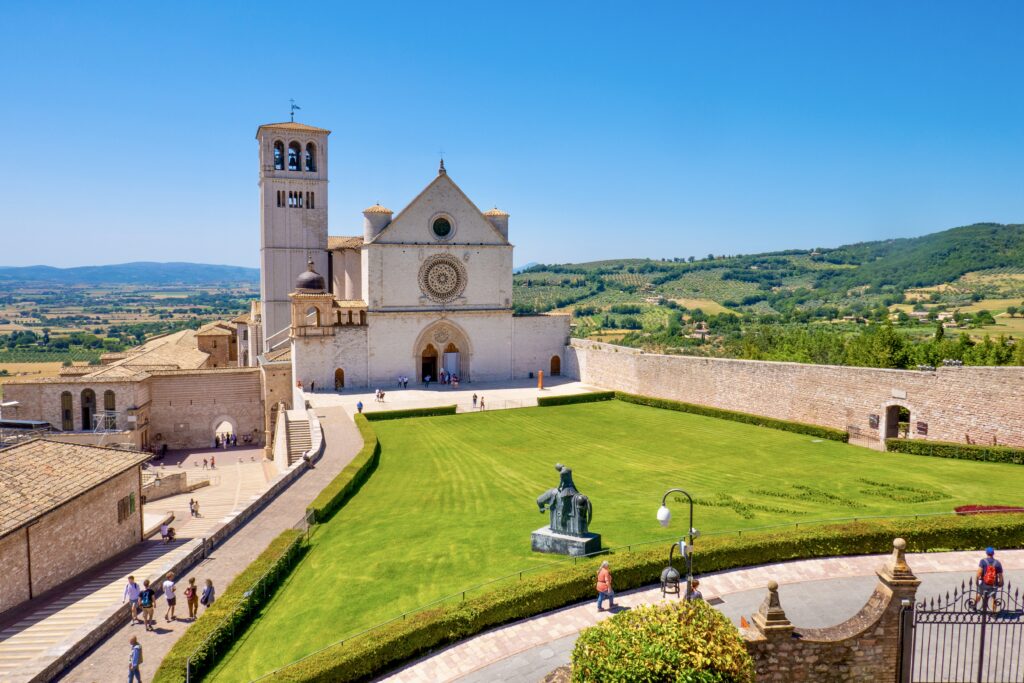
The beautiful basilica dedicated to Francis holds one of Italy’s greatest relic — Francis’ body and tomb.
But you don’t have to be religious to love Assisi.
The town has a perfectly preserved medieval quarter where bougainvillea vines tumble over limestone. It’s famous for its gorgeous frescos from the early Renaissance and historic monuments.
In this Assisi travel guide, I highlight the must-see attractions and best things to do to make the most of your visit.
>>> Click here to book a walking tour with a visit to the basilica
A Short History of Assisi And Saint Francis
Assisi has been continually inhabited for 3,000 years. In ancient Umbria, Assisi was a flourishing town, established in the 6th century B.C.
By 90 B.C., Assisi came under the jurisdiction of Rome and was governed by Emperor Augustus. The Romans called the water from Subasio’s springs “magic water.”
In 41 B.C., Assisi was conquered and became part of the neighboring town of Spello. Later, it became part of the Duchy of Spoleto.
In the 5th and 6th centuries A.D., after the fall of Rome, Assisi was captured by the Goths. By the 12th century, Assisi was liberated and established itself as a free commune.
Though the town was free, it wasn’t peaceful. For two centuries, Assisi was constantly at war with Perugia. In the next century, it came under papal dominion.
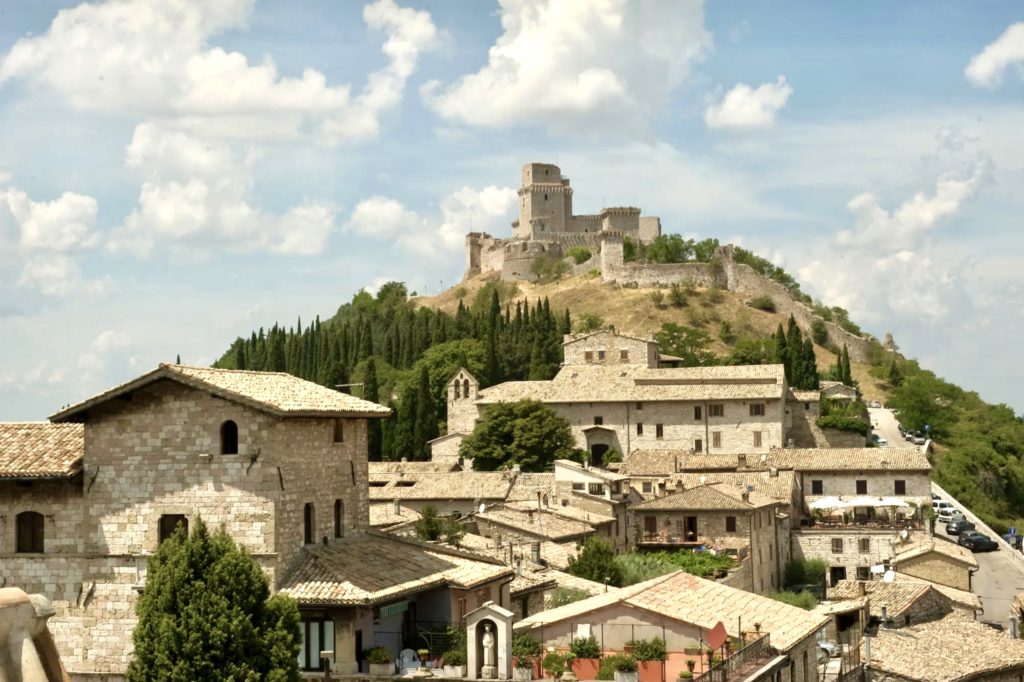
During this same time, St. Francis of Assisi was born in 1182. Saint Francis was a little man who rocked the rigid 13th century Catholic world. He’s the most popular Italian saint.
For the first part of his life, Francis lived in the fast lane. A charming socialite, he drank in taverns and picked up the tabs of his hard partying companions.
Not finding meaning in this lifestyle, a reformed Francis turned to prayer. He dressed in rags and hung out in a dilapidated chapel like a bum. Francis vowed to dedicate his life to poverty, humility, simplicity, and anti-materialism.
Some thought Francis was crazy. But the youth of Assisi were entranced by Francis’ all-or-nothing evangelical zeal and vision of a different life.
Plus, the tonsured Francis was a charismatic speaker, often wildly gesticulating during his sermons. Francis’ biographer called his gestures a “second tongue.”
Followers came in droves, forming a sort of brotherhood or commune that adopted a utopian Christian lifestyle.
It was a philosophy in which the Earth and all living creatures were respected as God’s creation, not viewed as inherently sinful. The brotherhood gained papal approval in 1210.
Francis traveled the world preaching his cause. In 1224, after 40 days of fasting, he received the stigmata (the wounds of a crucified Christ). This had never happened before in history.
Assisi flourished during Francis’ tenure and Franciscanism rapidly spread. Dozens of churches, monasteries, and public buildings were erected. The city walls began to emerge.
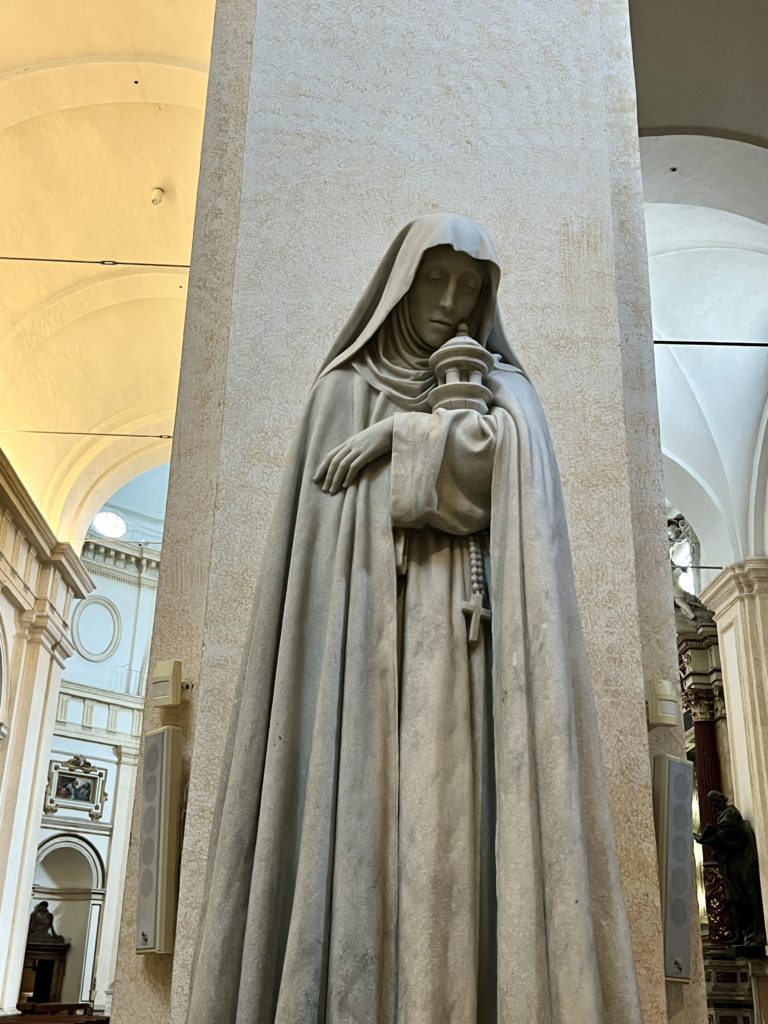
Francis died in 1226 and was speedily canonized in 1266. In 1979, Pope John Paul II named Francis the patron saint of ecologists. In 2013, the current pope took Francis’ name as his own for the first time.
Among Francis’ early followers was a devout girl named Clare. Born to a wealthy family, a 19 year old Clare ran away from home to join Francis’ brotherhood. Her sister Agnes also joined forces.
Francis put the two sisters in charge of the Church of San Damiano and established a female order. Clare spent 40 years fighting to preserve her monastic order, which preached poverty, charity, humility, and seclusion.
The rule of the Order of Poor Ladies was finally approved by the pope two days before her death. Clare became a saint in 1255.
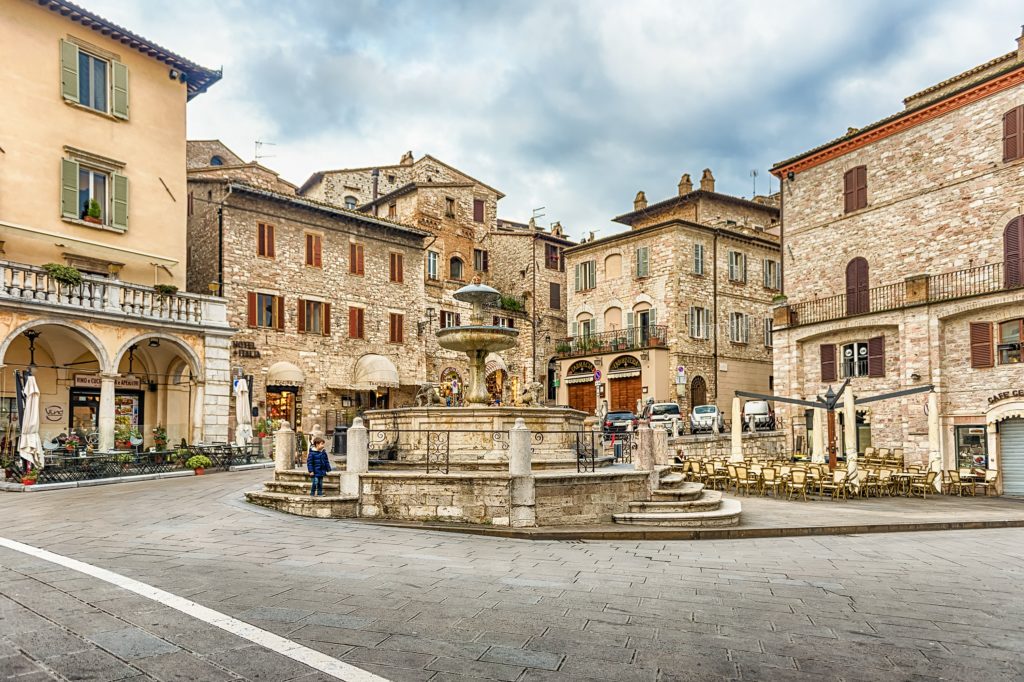
Best Things To Do And See In Assisi
With that backdrop, here’s my list of the must dos in Assisi.
1. Piazza del Commune
Assisi’s lively Piazza del Comune is the beating heart of the town.
As soon as you step onto the square, you’re greeted with the aroma of roasted chestnuts and the hustle and bustle of locals and visitors alike. The square is lined with cozy restaurants and ceramic shops, as well as an array of Franciscan souvenirs.
Although I had read that the piazza was mostly pedestrianized, it’s worth noting that it is still open to vehicles. So you need to be cautious while strolling around.
The piazza is a hub for some of Assisi’s top attractions, including the Temple of Minerva, the Roman Forum ruins, and the Palazzo del Capitano del Popolo with its towering structure.
While the Torre de Popolo is currently undergoing renovation, visitors can still marvel at the impressive sight of the tower, which stands tall in the square.
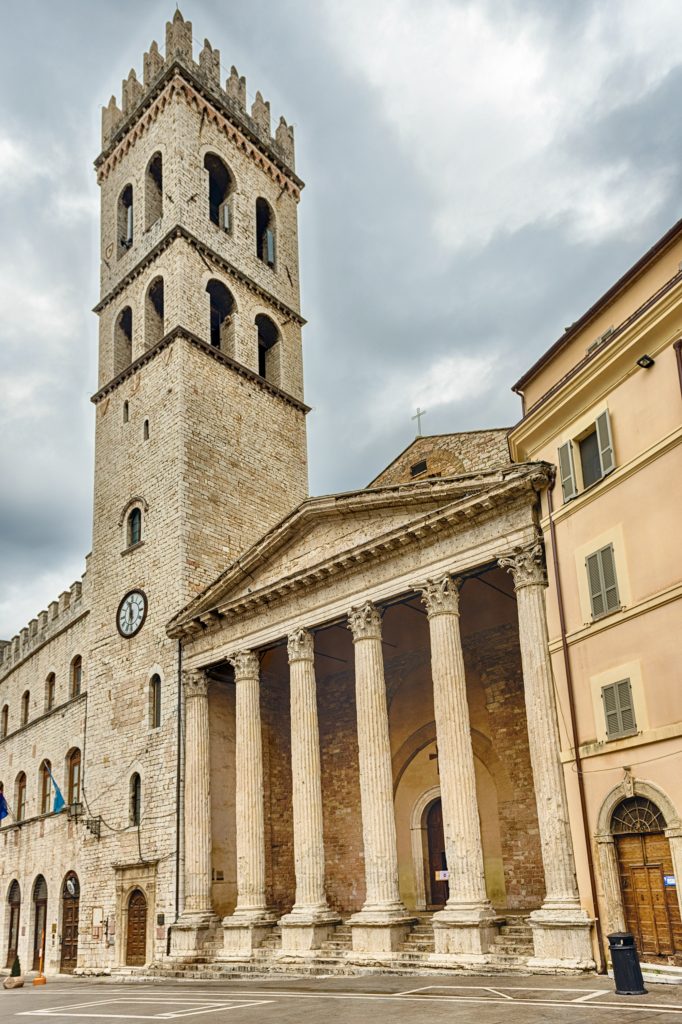
2. Temple of Minerva
The Temple of Minerva is the best preserved ancient monument in Assisi. It’s found on the north side of the Piazza del Commune.
Minerva is the Roman equivalent of the Greek Athena, goddess of wisdom and protector of cities.
The temple was once the centerpiece of Assisi. It dates from the 1st century B.C. and dominated Assisi’s Roman Forum. It has six massive Corinthian columns at the front that rest directly on the steps.
The architrave, or main beam across the columns, once held a bronze inscription of the names of the supreme Roman magistrates.
While the facade of the ancient temple is preserved, the interior structure was demolished in the sixteenth century to make way for the Church of San Nicolo.
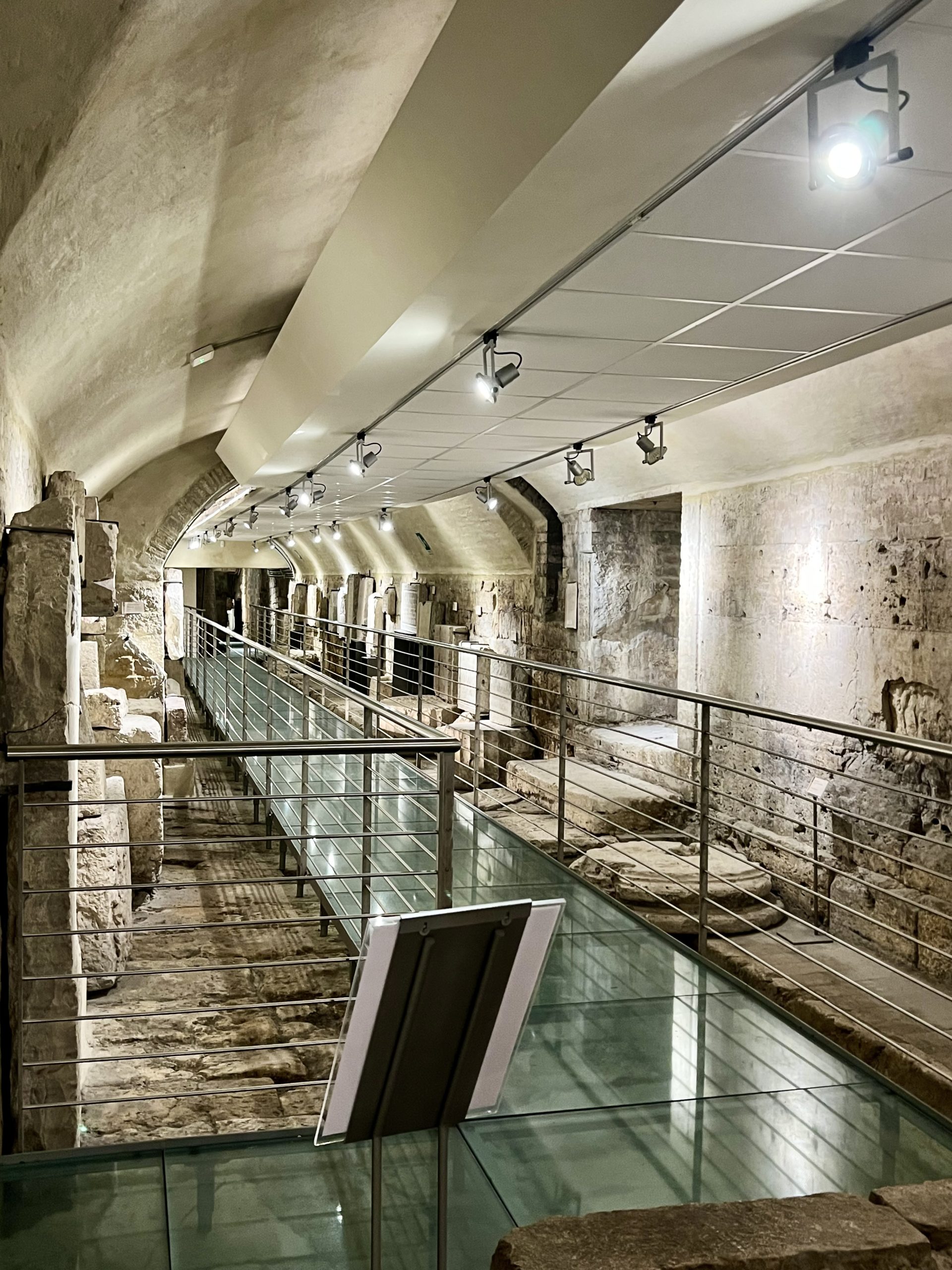
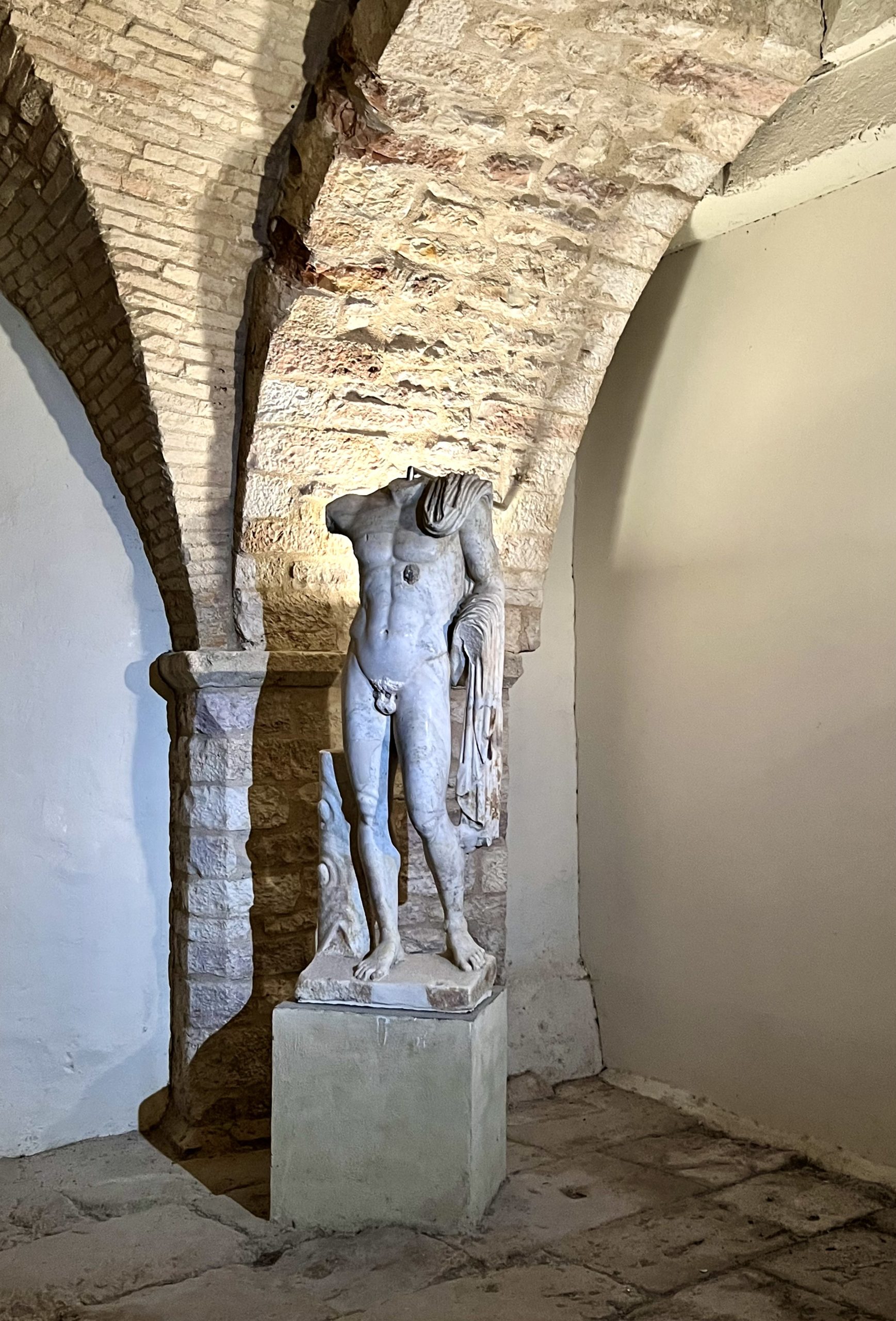
3. Roman Forum & Archaeological Museum
Visiting the Roman Forum in Assisi is one of the best things to do in the town, especially for history buffs.
The forum was discovered in 1836 under the Piazza del Commune. It was once the hub of the social, economic and political life of ancient Asisium.
Archaeological artifacts from the forum are on display in the Archaeological Museum (“Assisi Underground”) in the crypt of the former Church of San Nicolo.
You’ll see inscriptions, funerary steles and urns, fresco fragments, and several large Roman statues dating from the 1st century.
Then, you head into a long tunnel to view the ruins of the ancient forum. In fact, you walk right over the ruins on glass walkways.
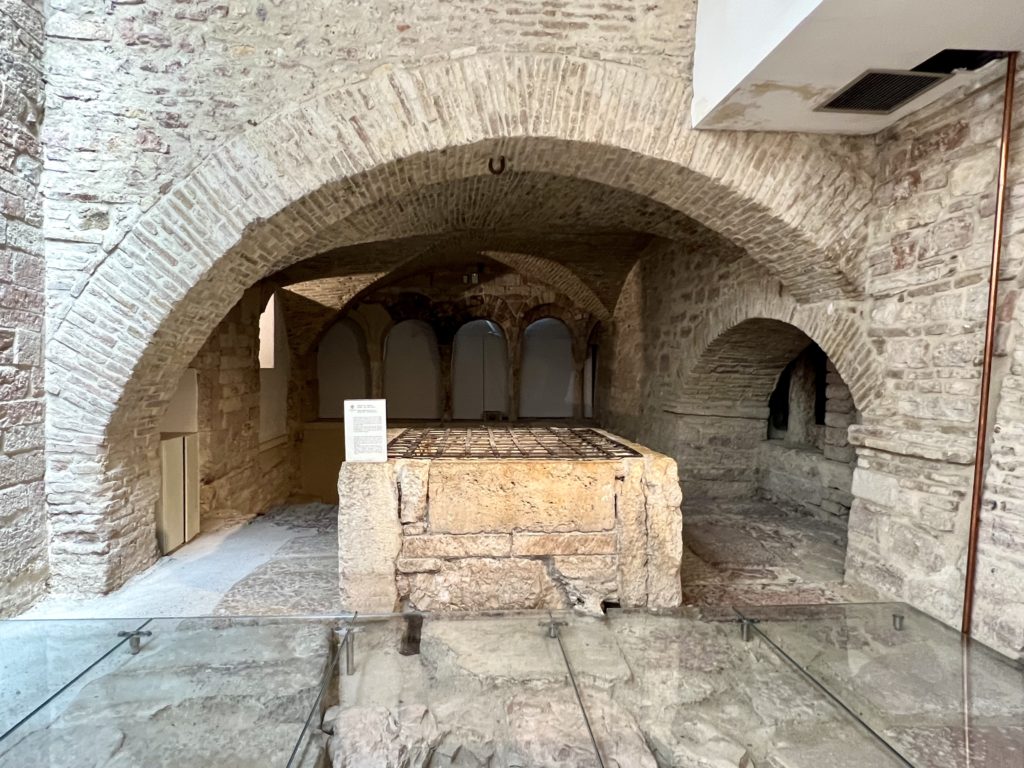
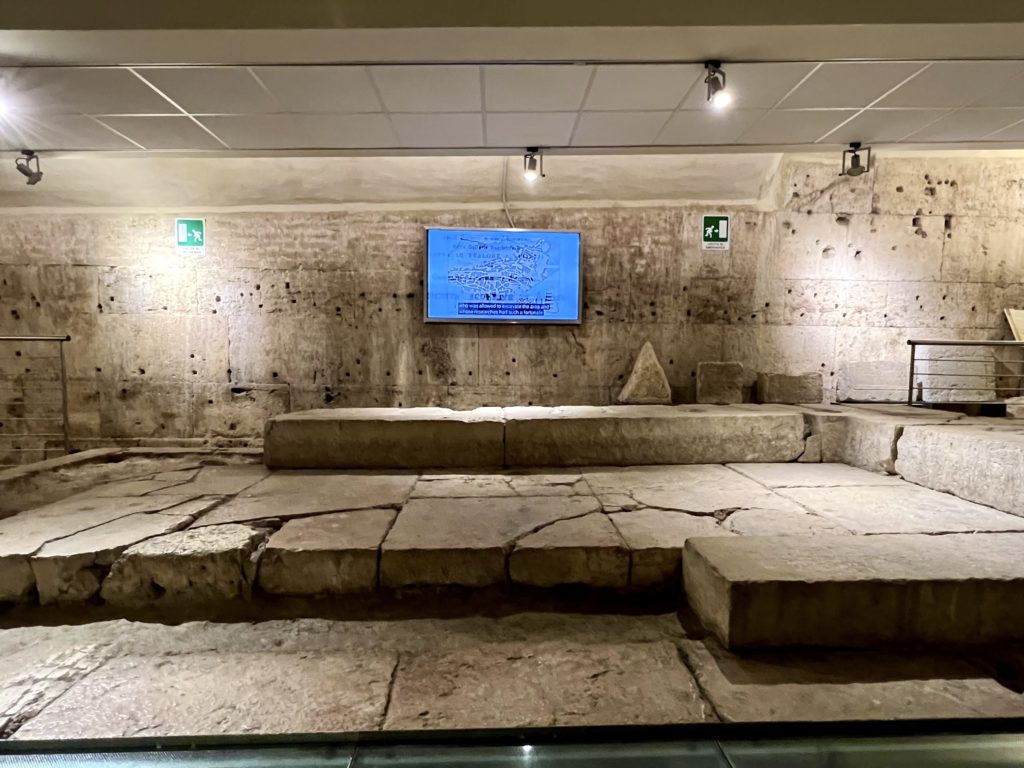
The travertine walls on the north side have a cistern at each end. Two symmetrical stairways lead up to the temple.
The eastern side of the forum has a row of taberna, or large covered halls. There’s a series of Doric columns from a portico that once surrounded the forum on three sides.
The central part of the forum contains the remains of a tribunal and podium. This was where speeches were given and justice meted out, as magistrates looked on from their surrounding seats.
The ruins also include a monumental cistern (shown above), a small temple dedicated to Castor and Pollux, a monumental fountain, and remains of a few shops.
If you’re roasting under the Umbrian sun, this space is nice and cool. It’s also well signposted in English.
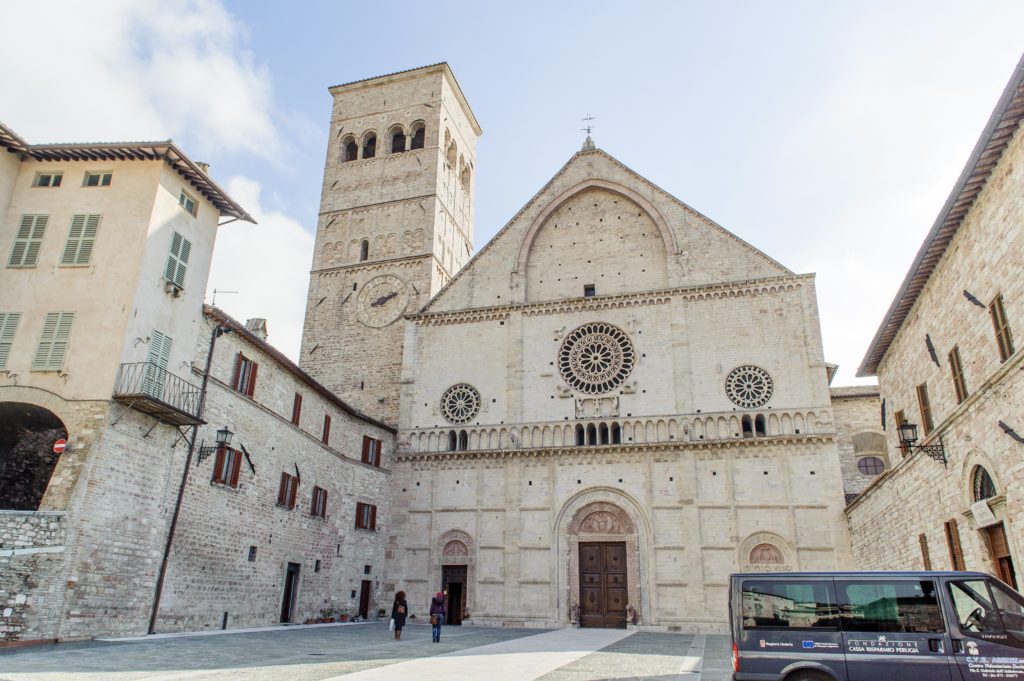
4. Assisi Cathedral
Assisi’s Duomo is the Cathedral of San Rufino and a must visit landmark in Assisi. This is the church where St. Francis and St. Clare were baptized. You can even see the baptismal font itself.
The doughty church has been rebuilt several times, beginning in the 11th century. The facade and rose windows are masterpieces of the Umbrian Romanesque style. The interior is all Renaissance.
You can visit the interior of the cathedral, a museum, a crypt, and climb the campanile or bell tower. It’s all very well organized.
It makes sense to climb the bell tower first before inspecting the rest of the church. At the beginning of your climb, there’s a modern stairway. Then the steps become somewhat uneven.
But there are good handrails the whole way and a few landings where you can rest on the climb. It’s quite steep at the very end.
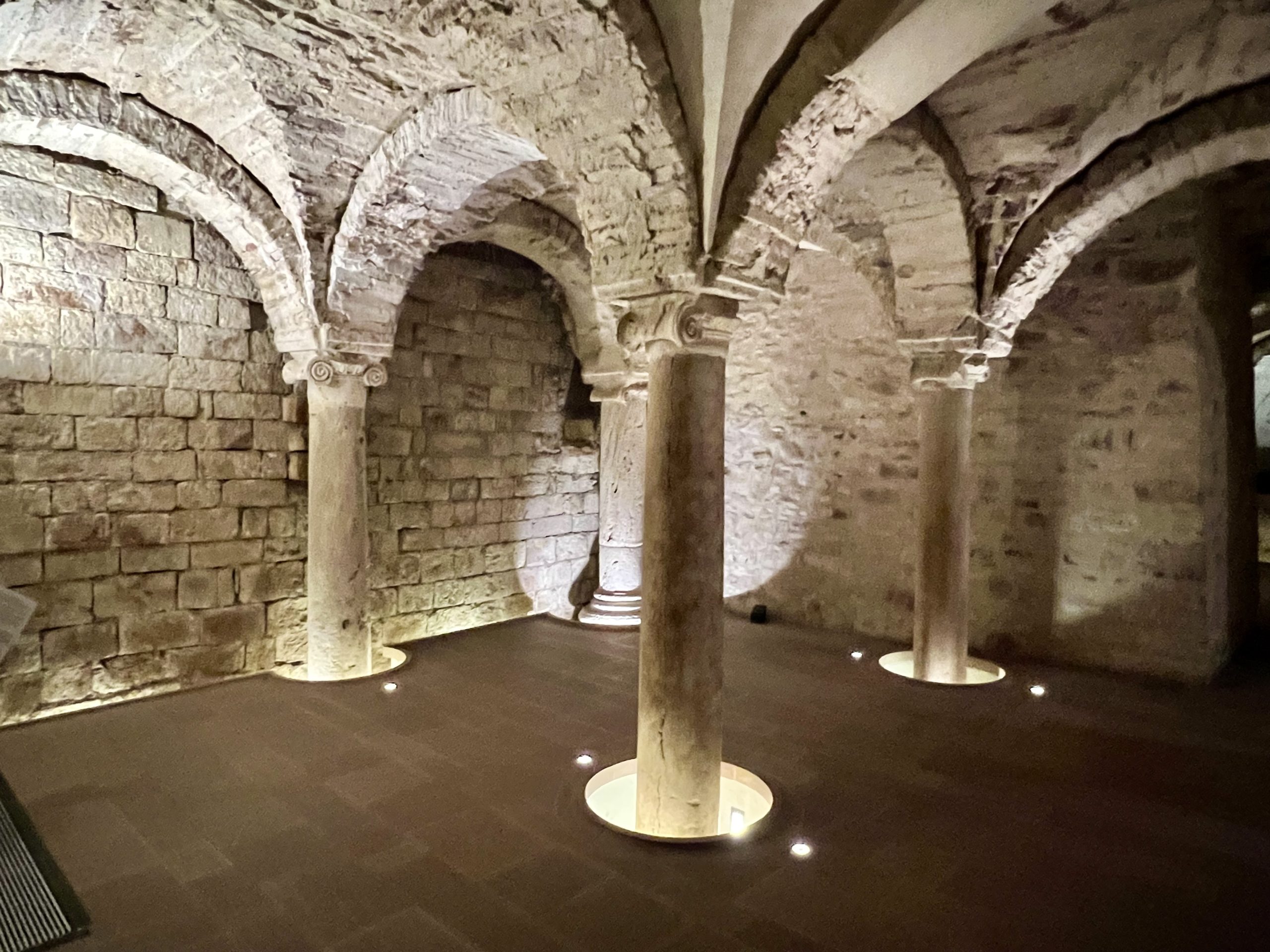
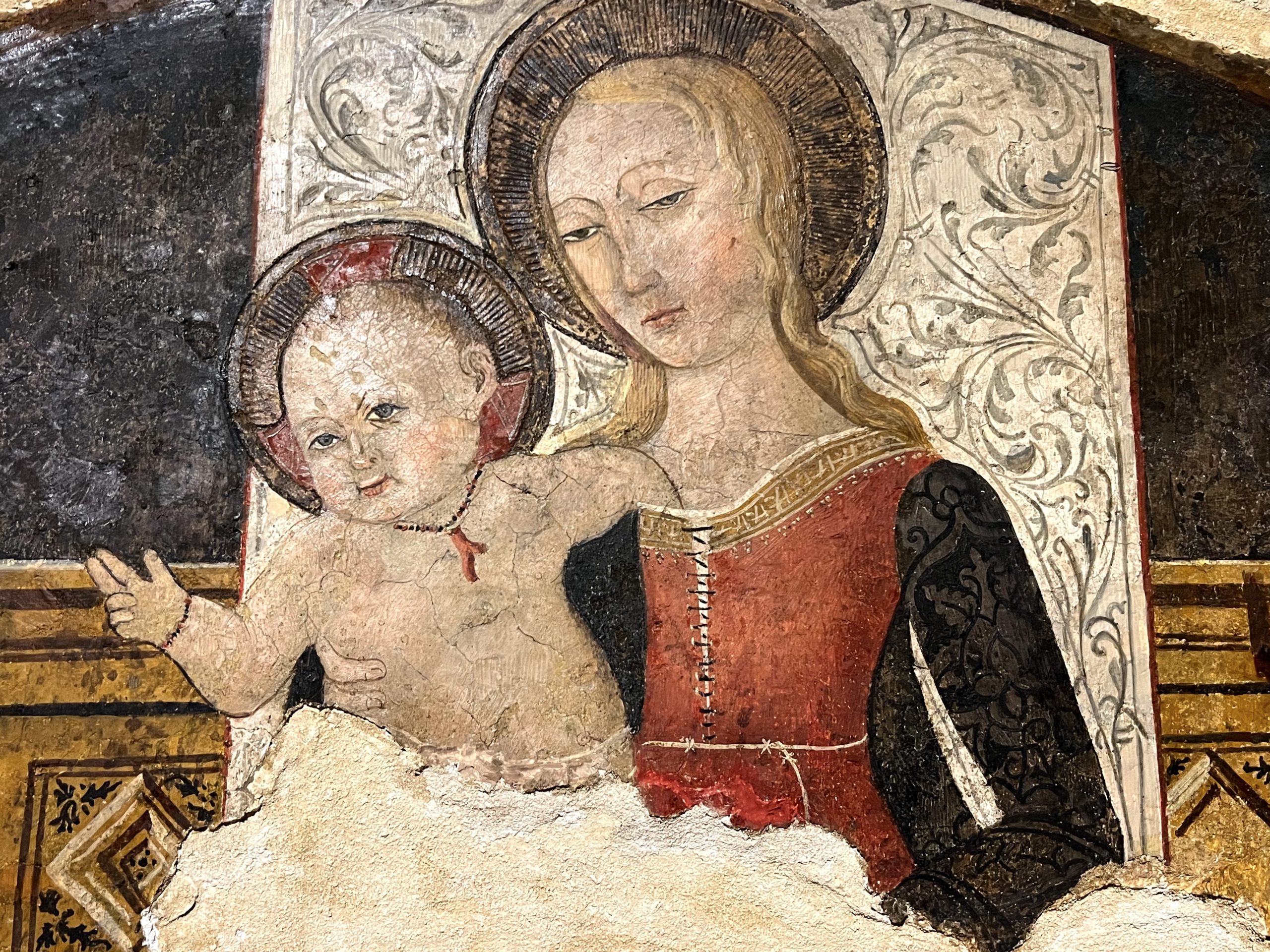
There are spectacular views from the tower. Unfortunately, there’s a metal screen, which mostly precludes getting good photos.
In the right nave of the church, you’ll find the stairway down to the crypt and the Diocesan Museum. The crypt is where St. Francis once prayed.
The museum contains a collection of archaeological artifacts, paintings, ancient and modern frescos, and furnishings from the church (including an episcopal throne).
Entry to the cathedral is 1.5 euros. The bell tower and the crypt are another 2.5 euros.
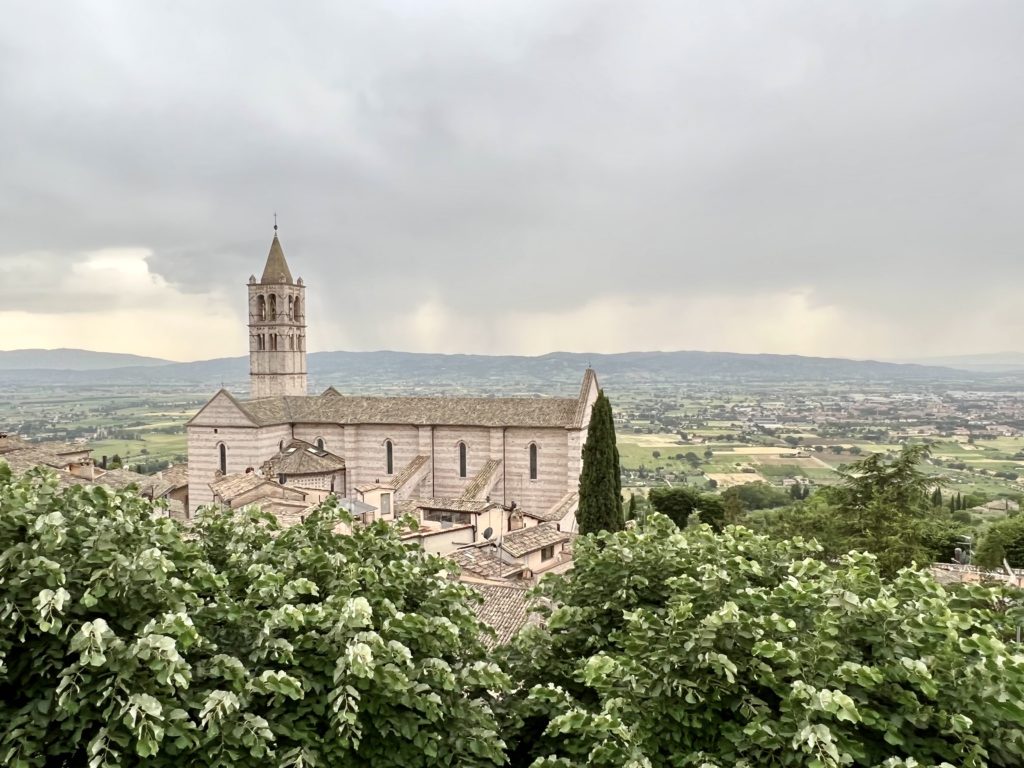
5. Basilica of St. Clare
Construction of the Basilica di Santa Chiara began a year after Clare’s canonization in 1255.
It was built in the Gothic style over a pre-existing church. The rather muscular rampant arches on the side were added in the 14th century.
The church is made of pretty pink and ivory marble. Inside, the church is dark and decorated with Giotto-esque type frescos.
Clare’s remains were transferred here in 1260 from the Church of St. George, also in Assisi. Her bones are now in the basilica crypt built with beautiful pink and green marble.
Clare is buried alongside the Byzantine cross of San Damiano, which Francis prayed to before receiving his mission from God. Clare’s sister Agnes is buried in a chapel in the left nave.
Be forewarned if you’re day tripping, the basilica is closed from noon until 2:00 pm.
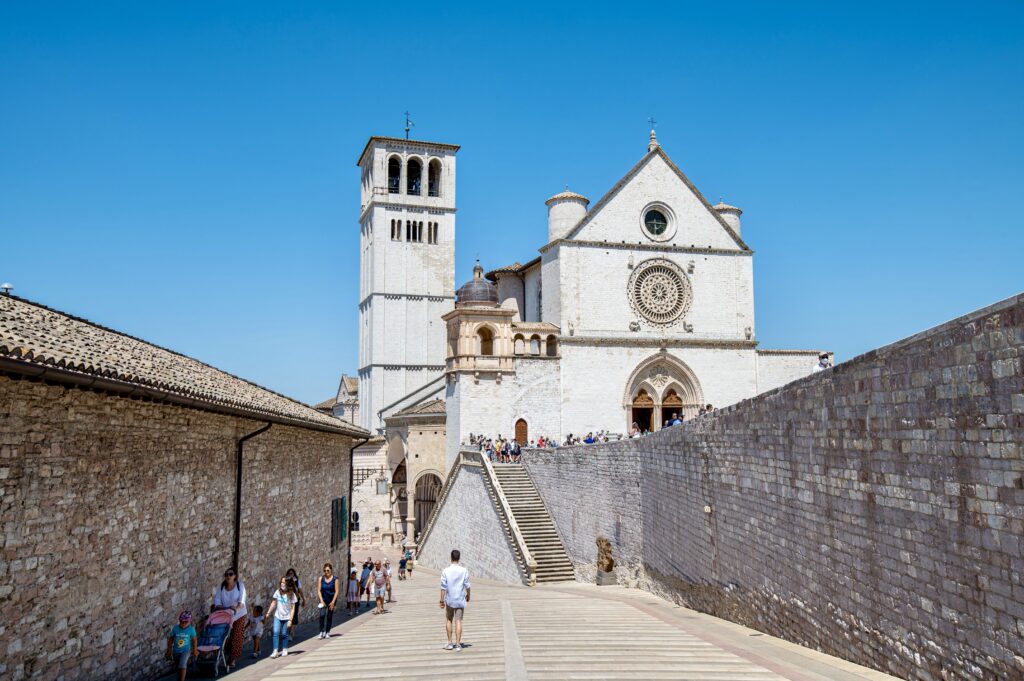
6. Basilica of St. Francis
The 13th century Basilica of St. Francis is the top attraction and best thing to do in Assisi. The basilica is one of Italy’s most beautiful and most visited churches and a religious and artistic highlight of Europe.
Building began in 1228, just days after Francis’ death.
The greatest artists of the Early Renaissance converged on the basilica to decorate it. They created a radical new style of Italian art, replacing Byzantine stylization with naturalism.
The seeds of the Renaissance created in Assisi would blossom decades later in Florence.
Everyone who was anyone in the Early Renaissance painted the walls of St. Francis. It’s an all star line up of artists from the late 13th and early 14th centuries — Simone Martini, Pietro Lorenzetti, Cimabue, Pietro Cavallini, and (possibly) Giotto and his workshop.
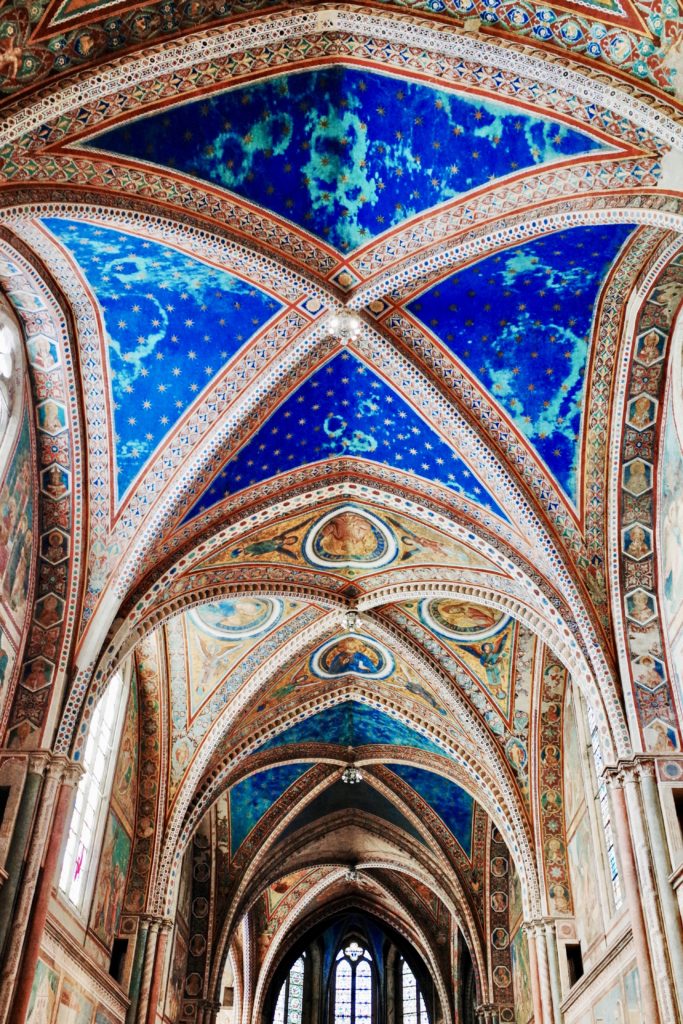
There are two levels to the church — the lower church (for pilgrims) and the upper church (for clergy). You’ll want to see the lower church, the tomb of Saint Francis in the crypt, the cloister, and the upper church.
You start in the Romanesque lower basilica, which was completed in 1230. Though it’s often described as “dark,” I found it light filled.
High tech lights, hidden in iron chandeliers, do a masterful job of highlighting the blue starry ceiling and precious early Renaissance frescos. You’ll find works by Simone Martini, Cimabue, Pietro Lorenzetti, and possibly the great Giotto.
Cimabue painted what is believed to be the first and most accurate portrait of St. Francis.
From the lower basilica, a stairway opens up to the Large Cloister of Sixtus IV and its beautiful arcades.
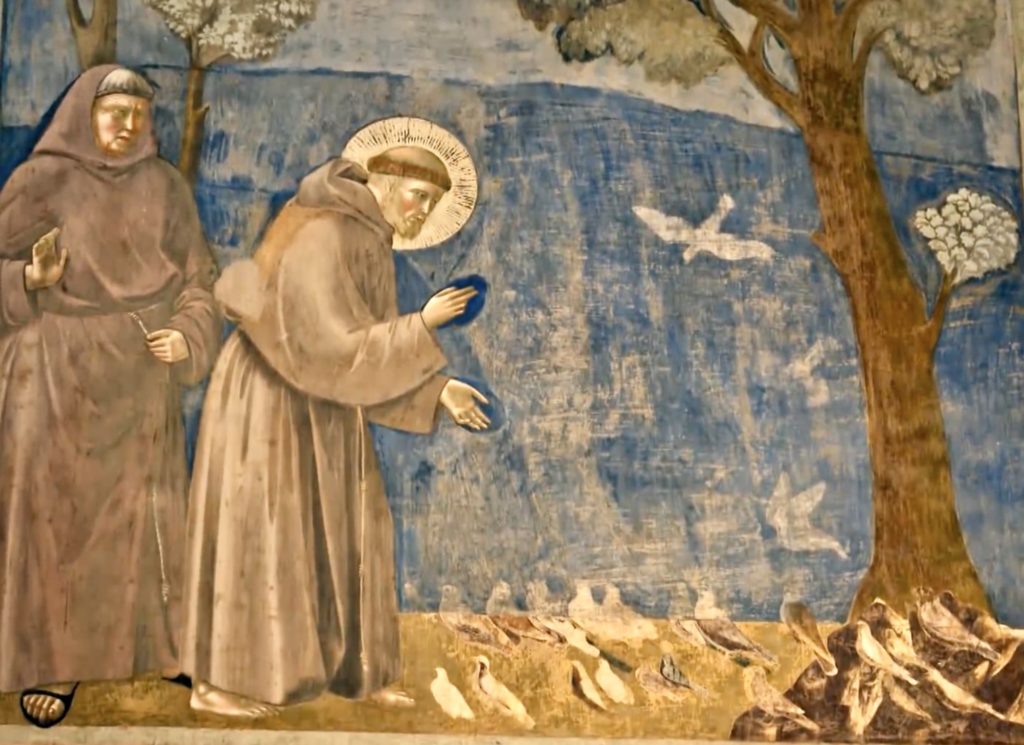
The upper basilica was built in the elegant French Gothic style. It’s been called the “most beautiful house of prayer in the world.” It has stunning 13th century stained glass windows, which are the oldest in Italy.
In the center aisle, you’ll find a famous fresco cycle attributed to Giotto and his school. It’s a series of 28 frescos in the lower register of the nave.
They depict scenes from the life of St. Francis, from his playboy youth to his death, as he embraced and preached spirituality over materialism.
There are also Cimabue frescos, a Crucifixion and a Deposition, in the transept and apse. The frescos look like photographic negatives.
This is because Cimabue used lead based paint. Over time, it oxidized and the silver paint turned black, giving the frescos a surrealistic look.
The entrance to Saint Francis’ tomb is halfway down the nave. Staircases on both sides lead you down to the crypt.
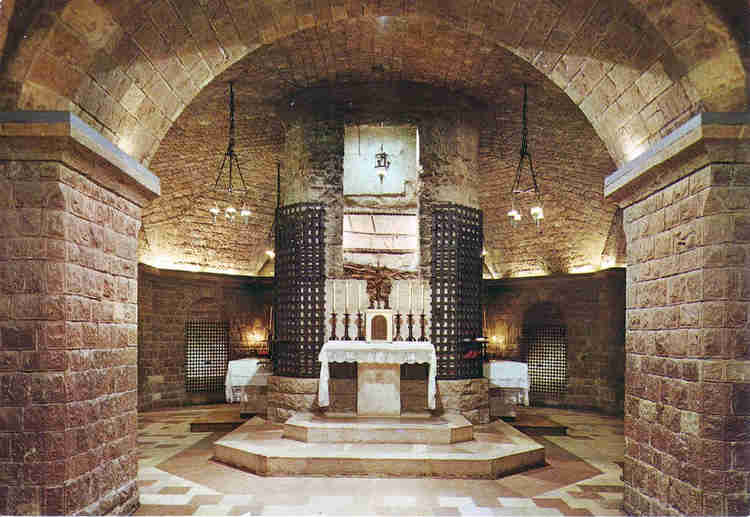
There’s no coffin or sarcophagus. His remains are inside a (heavily protected) stone pillar that you can walk around and touch.
The tomb was hidden for 600 years, only discovered in 1818. It was restored in 2011.
In 1997, an earthquake hit Assisi, killing 11 people and displacing some of the precious frescos in the upper basilica. They received a $27 million restoration.
When visiting, you’ll need to wear modest attire covering your knees and shoulders to enter the basilica. But, if like me, you’re wearing shorts, the monks will hand you a piece of cloth to cover your legs.
Here’s my complete guide to the Basilica of St. Francis of Assisi.
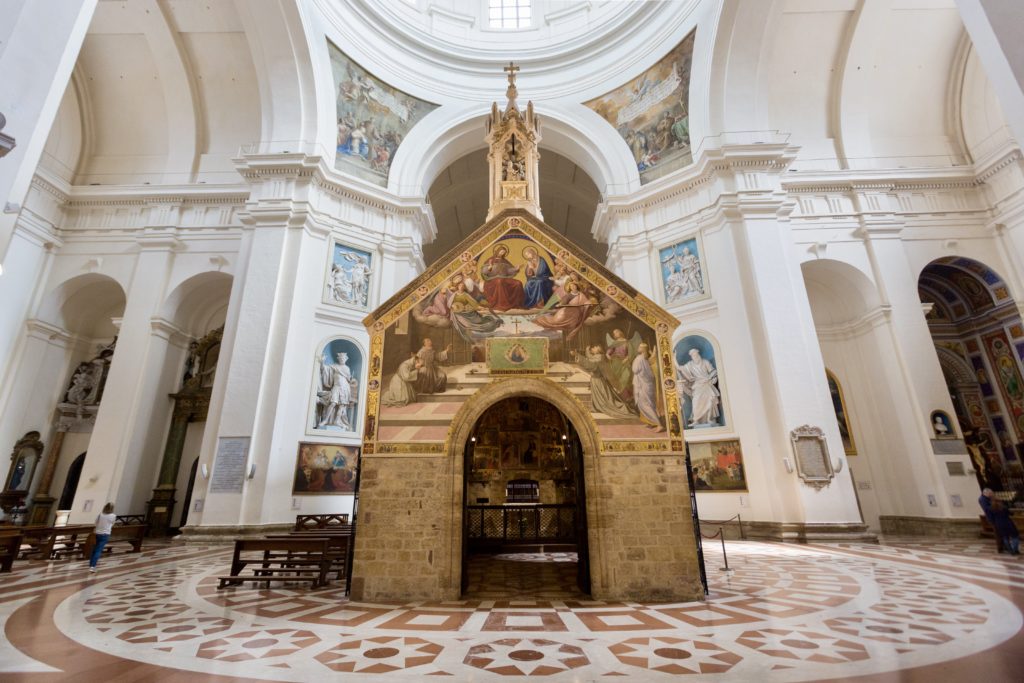
7. Sanata Maria Degli Angeli: Francis’ Porziuncola
In his early days, Francis lived in the ruins of a chapel. It was here that he had a famous vision. Christ came to him and said, “Go Francis, rebuild my house which has fallen into ruin.”
Christ was referring to the decadent monks and the corruption of the Catholic Church, which was plagued with nepotism, simony, and indulgences. But Francis misinterpreted the vision.
In 1209, instead of reforming the church, Francis began rebuilding the tiny fix-er-upper chapel. The stone chapel is known as the Porziuncola. It’s now on display inside the Church of St. Mary in Assisi.
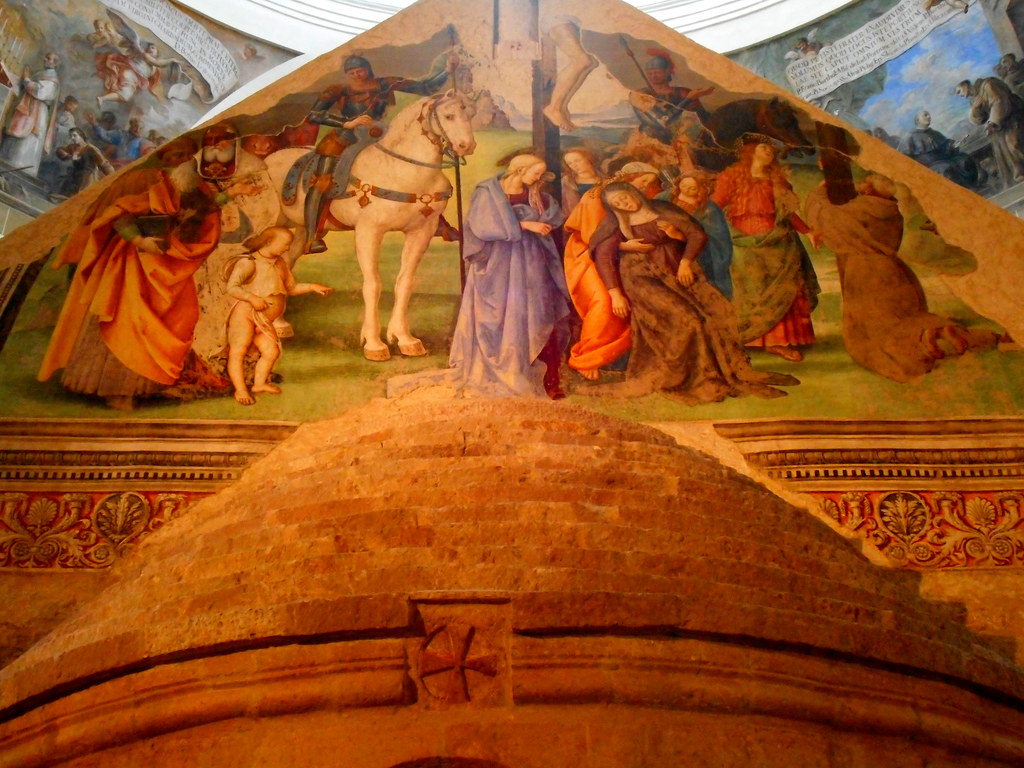
The Porziuncola was where the Franciscan religion was launched. The word means “small portion of land.” The facade of the stone chapel is frescoed by artists including Perugino.
The grandiose Baroque church of St. Mary of the Saints was built in the 16th and 17th centuries specifically to hold and protect the Porziuncola.
Behind the Porziuncola is the Chapel of the Transit, the cell where Francis died. It contains a statue of St. Francis on the very spot where he preached to doves.
The basilica is outside of the old town, a short walk from the train station at Via Porziuncola 1.
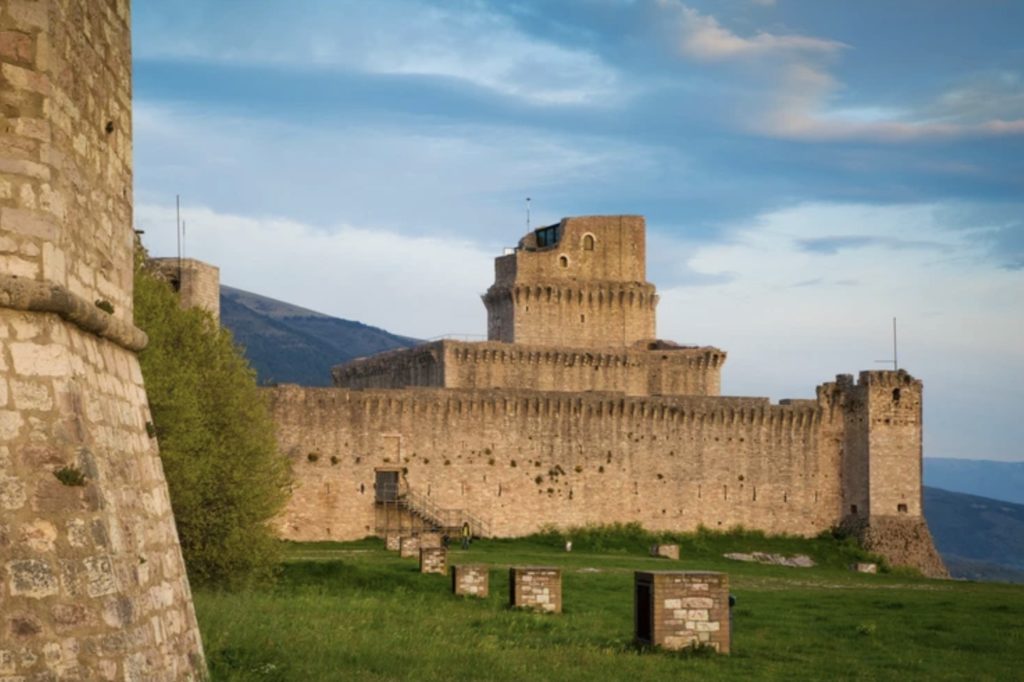
8. Rocca Maggiore
Dating back to the 13th century, Rocca Maggiore is a formidable fortress that was originally constructed by Charlemagne after his conquest of Assisi. Over the centuries, the fortress was expanded and modified multiple times, until the 16th century.
The Rocca is a rugged castle that boasts a labyrinth of tunnels, hidden corners, and even a slightly cramped turret to climb. Throughout its history, the fortress has served as a residence, a prison, and a warehouse.
To reach the Rocca, you’ll need to embark on a steep hike. But the effort is rewarded with breathtaking views of Assisi, its majestic churches, and the Spoleto valley.
It’s important to plan your visit to Rocca Maggiore accordingly, as the fortress closes at 4:00 pm. So, it’s advisable to start your hike well in advance of closing time to have sufficient time to explore this impressive fortress.
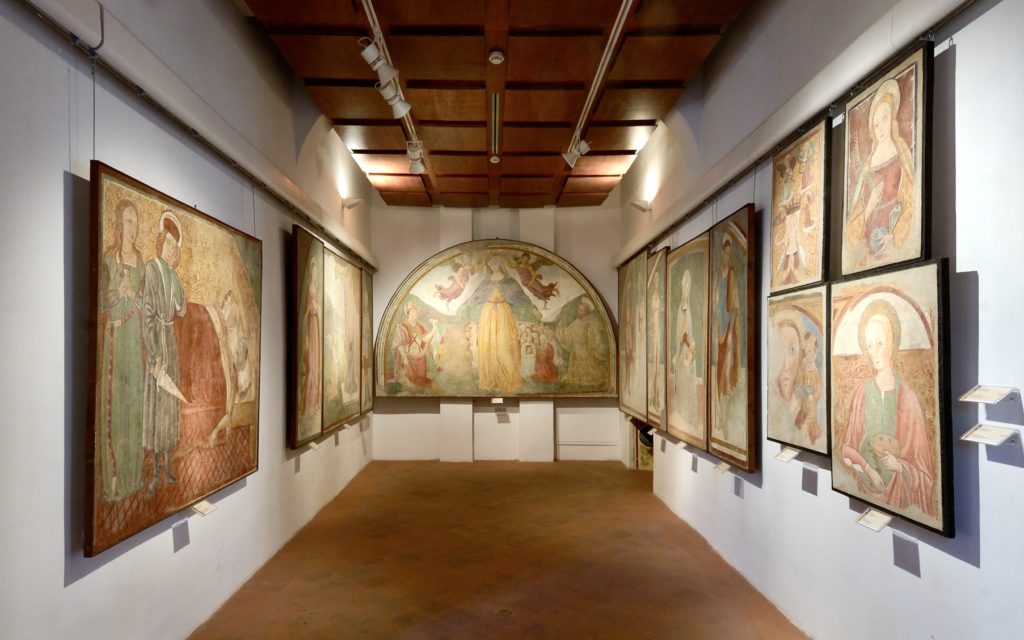
9. Palazzo Vallemani
The Vallemani Palace is a beautiful Baroque building that was lavishly frescoed in the 17th century. It’s located on Via San Francesco, not far from the basilica.
The palace houses the Pinacoteca Communale, a museum of religious art.
It showcases detached frescos from the Middle Ages to the 17th century. It’s also home to a Maesta (Mary seated in majesty) attributed to Giotto.
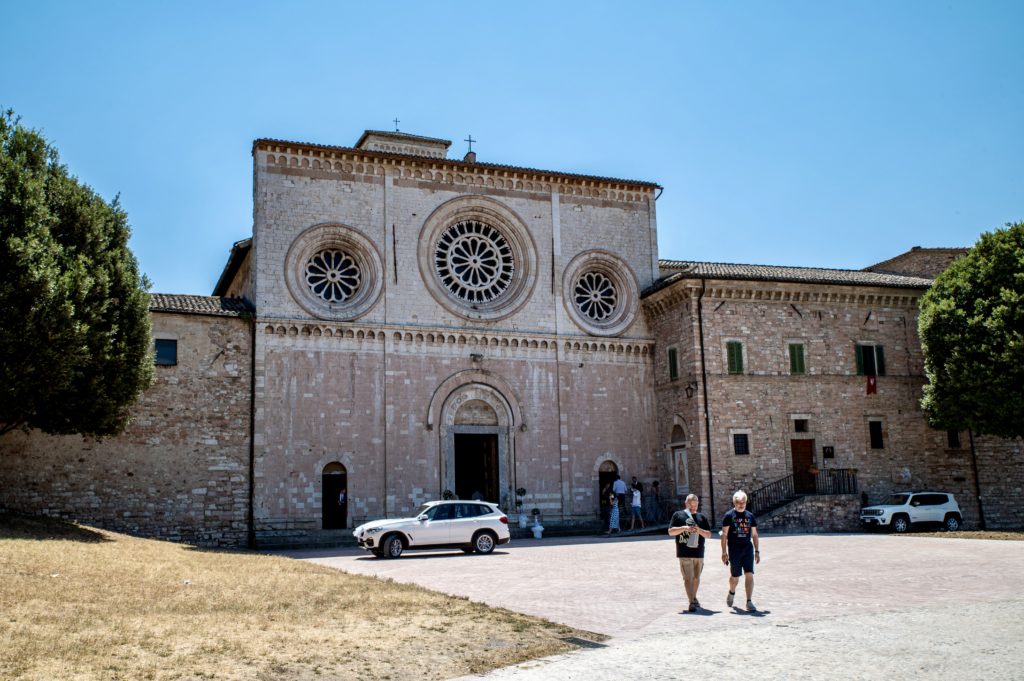
10. Church of St. Pietro
This Romanesque church on the edge of Assisi dates from the 10th century. But it was mostly built in the 13th century.
The interior features a stunning cupola, Gothic graves, and the remains of medieval frescos.
Just to the right of the church is the Museo San Pietro. It houses a triptych by Matteo de Gauldo.
11. Ermeo delle Carceri Monastery
This monastery is a 10 minute drive from Assisi, hidden away in a dense forest. It’s a place where Francis came for solitude. You can feel the true spirit of Francis.
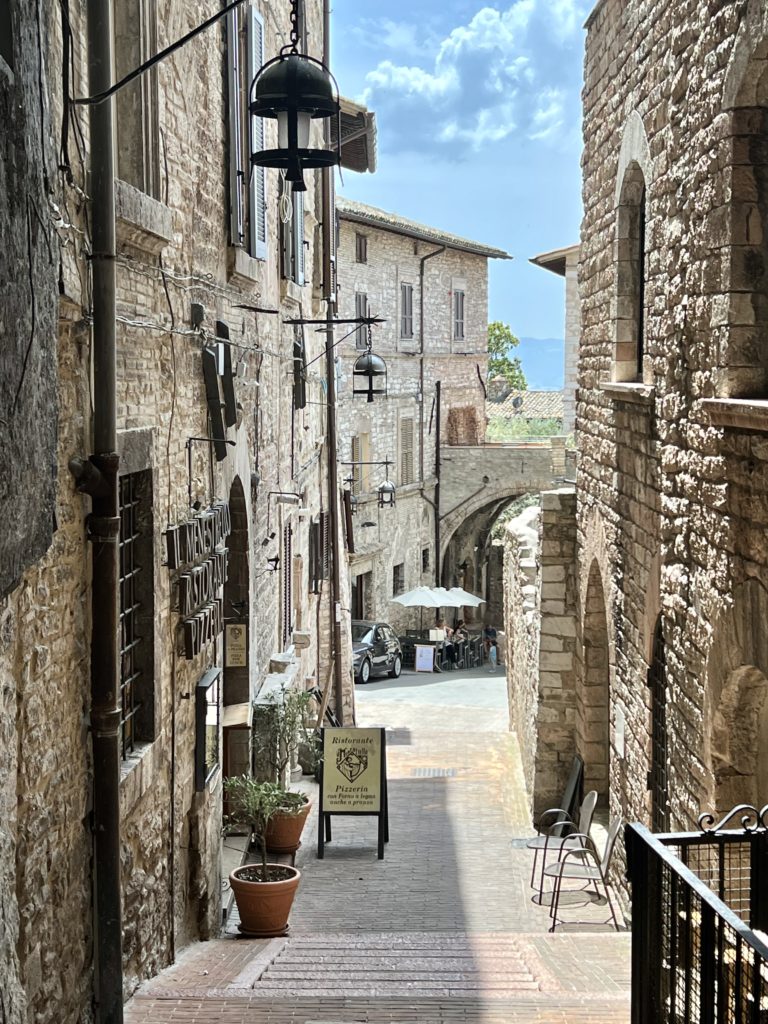
Tips For Visiting Assisi
Here are some must know tips for exploring all the top attractions in Assisi.
1. How To Get To Assisi
Assisi is located in the Umbria region of central Italy. It’s situated on the slopes of Mount Subasio and overlooks the picturesque Umbrian countryside.
It’s 16 miles from Umbria’s capital, Perugia, and 112 miles from Rome.If you’re driving, Assisi is 2 hours from Rome, 2:11 from Florence, and 30 minutes from Perugia.
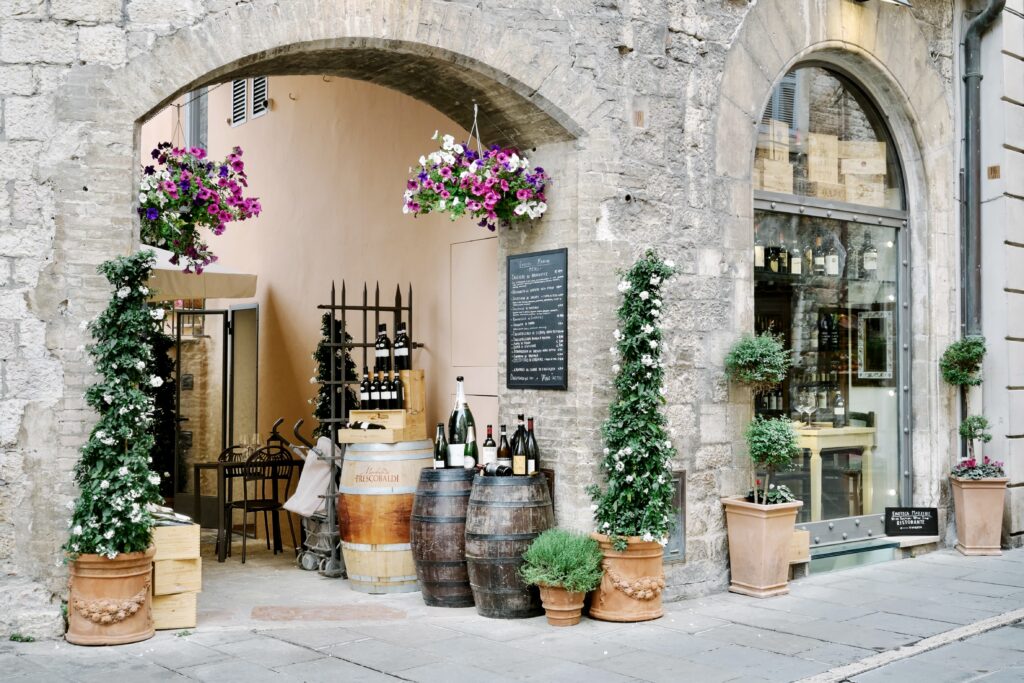
You can also get to Assisi by train. The train station is located below the town. Shuttle buses run between the station and the town.
If you are driving by car, you need to park in one of the parking lots outside the town walls. The centro storico is off limits to vehicles except for residents.
The best parking places are at the Port Nuova or Matteotti lots. You’ll see signs as you approach the city.
If you park there, you’ll arrive at the east end of the town. Assisi is about one mile long. The Basilica of St. Francis is at the westernmost end.
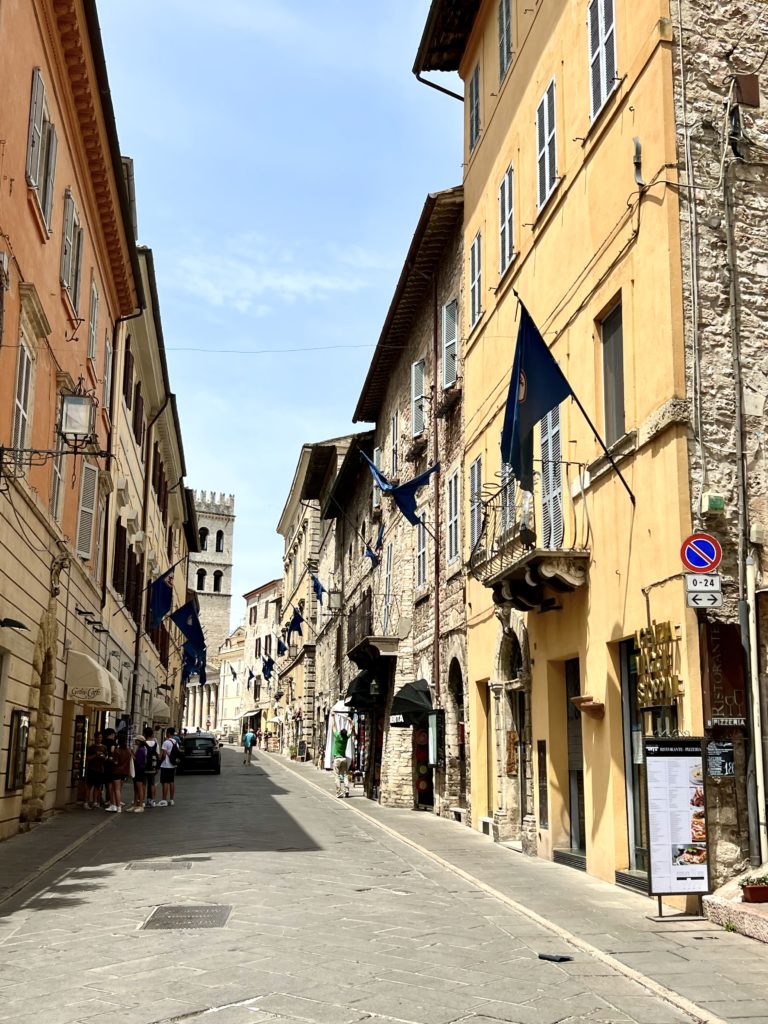
2. Guided Tours To Assisi
If you don’t want to deal with the hassle of driving and parking in Assisi, there are plenty of guided tour options.
You can book a small group day trip tour from Rome or a private tour from Rome. You can also combine Assisi and Orvieto on a day trip from Rome.
You can also book a day tour to Assisi (+ Cortona) from Florence.
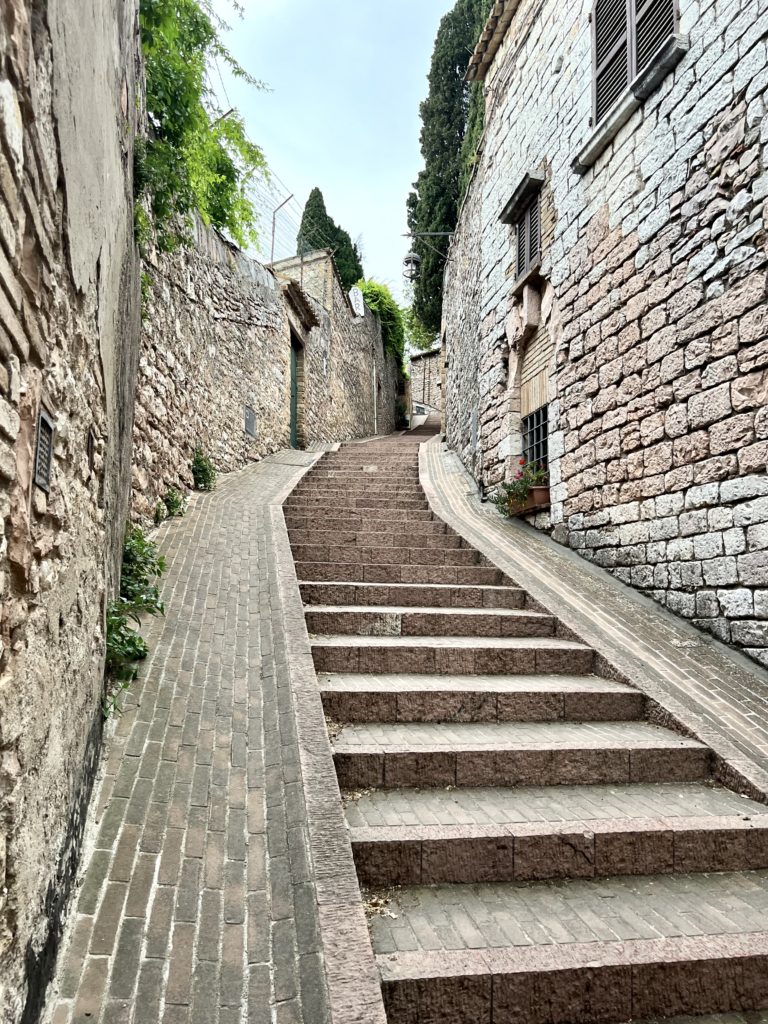
3. Getting Around Assisi
Assisi is entirely walkable. But it’s not exactly easy walking.
Everything in the town is vertical. It’s as if you’re supposed to suffer while making your pilgrimage.
It’s a good idea to book a guided walking tour once you’re there. In particular, there’s no signage in the Basilica of St. Francis. So, unless you’re an art expert or study up in advance, you may not know what you’re looking at.
I booked this 2.5 hour private Assisi tour, which was fantastic. The guide was a fount of knowledge about Assisi and its history. You can also book a 3 hour small group walking tour.
Be forewarned, the Main Street of Assisi, Via San Francesco, is very trafficky with cars whizzing by all the time. The side streets, however, are quiet and pedestrianized.
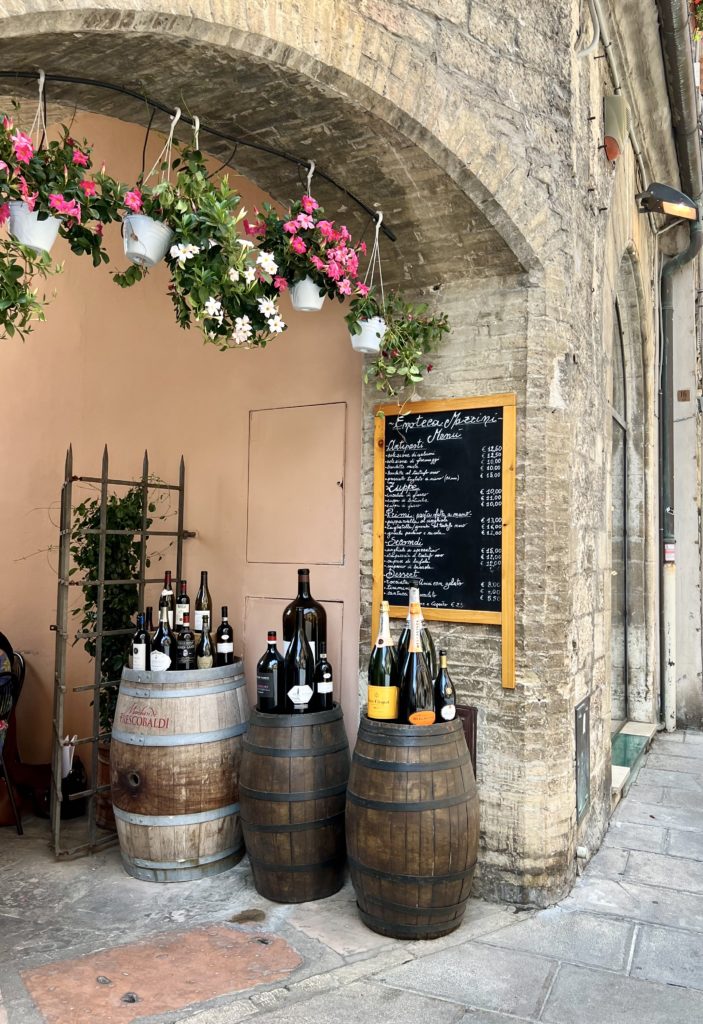
4. Where To Eat In Assisi
Assisi has several local specialties, including truffles, cured meats, lentil beans, black celery, honey, and prosciutto di Norcia.
If you are day tripping to Assisi, I can recommend two restaurants for lunch.
Il Vicoletto is a cozy spot located down a tiny lane with great food. Locanda del Podesta is a quaint restaurant with old world charm near the Basilica of St. Francis.
For spectacular views, you can eat at the Ristorante San Francesco Assisi or the Terrazzo di Porperzio.
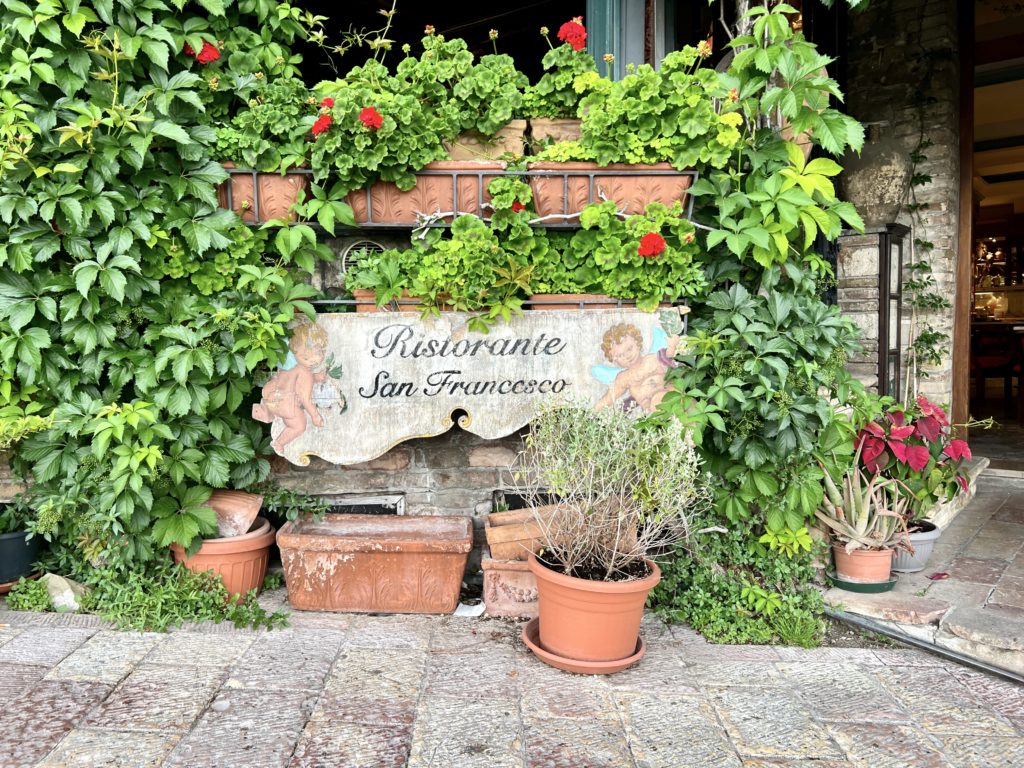
5. Where To Stay in Assisi
Staying overnight gives you the chance to experience Assisi without the day trippers, which account for 85% of Assisi’s visitors. There are some great places to stay in Assisi.
The Nun Assisi Relais and Spa is a romantic luxury hotel in a former 13th century convent. The Dal Moro Gallery Hotel is a hip designer hotel with a rooftop garden.
The Valle di Assisi Hotel & Spa is right outside Assisi in the Umbrian country side. It has a pool and terrace overlooking Assisi.
Another option is the Giotto Hotel, a tradition historic hotel right near the Basilica of St. Francis.
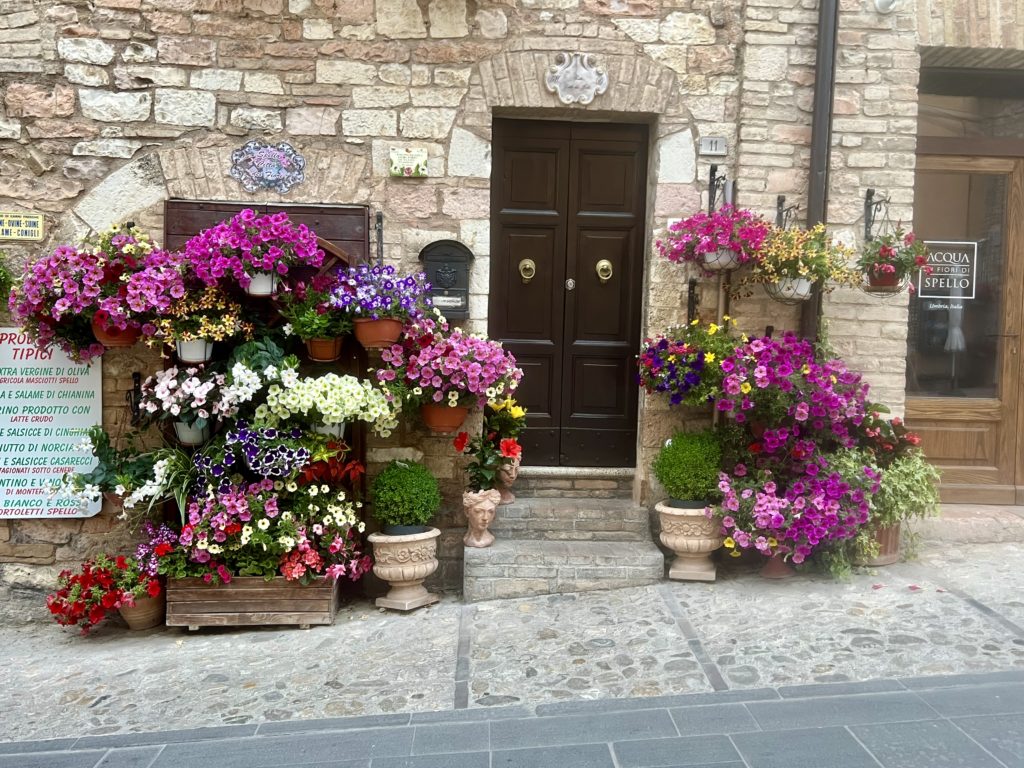
I hope you’ve enjoyed my guide to the best things to do and see in Assisi. You may enjoy these other Italy travel guides and resources.
- 5 day itinerary for Rome
- Hidden gems in Rome
- 1 day itinerary for Vatican City
- 3 day itinerary for Florence
- 2 day itinerary for Venice
- 1 day itinerary for Milan
- 10 day itinerary for Tuscany
- One Week in Umbria itinerary
- 10 day itinerary for Italy’s classic cites
- 11 ways to spend 1 week in Italy
- 30 beautiful towns in Italy
- 100+ Italy bucket list experiences
If you want to visit the top attractions in Assisi, pin it for later.

